Happy Times On the Carl and Elma Farm
No child could ever have wished for a more exciting place to visit grandparents than we had as grandchildren with the Kobler grandparents in Penokee. The house had an attic, lots of bedrooms on the second floor, plus a real bathroom with toilet and tub and running water (back then that was exceptional), on the first floor was a huge country kitchen, a living room, “sitting room” and large dining room. The basement was very large and had many interesting things to “investigate”.
The attic was a child’s dream. It was full of old magazines showing WWI and numerous other exciting things we’d never seen anyplace else. There were old cancelled checks which we use as “play money” (God forbid they needed any of them). There were old pictures and old clothes and so many wonderful things for a child to wonder about. We could dress up in the old clothes and hats and shoes. Set up a “house” and a “store” and a “bank” and be in business for a full day of fun. The bank was a corn dryer and each of us claimed one of the shelves for our “money” (the cancelled checks). Rainy days were no dull thing at the farm.
The sitting room had a hand crank record player. It was called a Victrola and there were lots of good old records including our favorite, “The Bum Song”. Before Donna and Juanita and I could read we would try out all the records trying to find that record. Once we found it we played it over and over. There were marches by John Phillips Sousa and numerous symphonies and other classical music. Also in this room was a viewer with double pictures which when placed in the viewer became three D. We could see the Grand Canyon, Yellowstone, Niagara Falls and numerous other well known scenic places. We spent many hours enjoying these picture cards.
The dining room had lead crystal cut glass windows in the upper fourth of the window as did the living room. The dining room table could hold twelve, I think, but we kids loved it because the adults sat in there and we got to sit away from them at an oval oak table in the kitchen. We also sat in there for breakfast where we got Granddad’s wonderful muffins. (I wish I had gotten his recipe, but he just sort of threw them together so I don’t know that there was one.) There were always enough for a mid morning snack and add to that a cup of milk and it was a kid’s feast.
Granddad always fixed breakfast. As I understood the story he told Grandmother when they got married he did not like to see a woman first thing in the morning without her hair done and whatever else she did for makeup, maybe a little color on the lips and cheeks and a bit of face powder. Anyway he promised to get breakfast if she would always come down dressed for the day. And she did. I do not ever remember Grandmother Kobler fixing breakfast. She probably did but I never saw her do it.
From a child’s view Grandmother had the most magnificent flower garden ever seen. It was full of roses, hollyhocks, daisies, marigolds, zinnias, pansies, gardenias, even little violets and so many seasonal flowers I cannot possibly remember them all. She took wonderful care of the garden and I do not remember seeing weeds in it ever. She often cut flowers from the garden and adorned the table. Sometimes as we got older we could be the flower gatherer. Donna and I used to take the hollyhocks and make dolls out of them. A bud for the head and a full bloom for the skirt made a lovely doll. We made several of them. Some with the same color of head as body and some varied ones. We arranged them on the porch and staged grand musicals. What fun! The roses smelled wonderful and there were so many different colors. The whole garden was a wonderful place to go for beauty and a lovely fragrant smell. No flowers have smelled as good to me as these did.
When we were younger there was an orchard northeast of the house and toward the chicken house. They had apples and pears and cherries as I remember. One winter was very hard on them, as I remember, though, and killed them. What wonderfully tasty cherry and apple pies she made almost daily. She also made rhubarb pie (rhubarb from her vegetable garden) and at Christmas mincemeat pie was a special treat.
Grandmother always grew all their vegetables. Her garden was huge and looking back I wonder how ever she managed to take care of such a big garden. Maybe Granddad helped her when they were not hard at work in the fields. She had potatoes, corn, tomatoes, melons, asparagus, lettuce, cabbage, rhubarb, and I am not sure what else. She did, of course, can much of it during the summer. She also made jelly and preserves. One day when I went with her to pull weeds a black snake came along and wiggled past us. She told me they are very good snakes and never to kill one. Recently I saw a U-tube video showing a black snake devouring a rattle snake at least as big as it was and recalled her statement.
Northwest of the house was an ice house. In the summer it was heaven to sneak in there and get cooled off. We kids did that until Granddad discovered what we were up to and let us know it was off limits because we were melting the ice. The ice was cut off the river (the South Solomon River ran through the north side of the farm) in the winter and hauled to the ice house. The ice house was a deep hole dug out with steps down the side to the bottom. They would layer the ice with straw and the straw insulated it allowing them to have ice for ice tea and lemonade and to make ice cream through-out the summer. It was something we took for granted, but really quite exceptional. No one had refrigerators back then. An ice box was used to keep milk and cream and butter from souring. We kids used to churn the butter from the cream in a big wooden churn. We took turns. It seemed like great fun. Later they got a glass churn and you could watch the cream turn into butter as you cranked the handle.
West of the house quite a bit was the classiest out house I ever did see, a three holer made of concrete with wooden seats, and a urinal. It was so sturdy I don’t believe anyone could have tipped it over on Halloween. (As happened to many out houses back then.) It was only used when the power was low and the water was not getting upstairs to the bathroom. Or when the bathroom upstairs was being used and folks could not wait. They “limed” it regularly so it never did smell bad like some out houses did.
Before REA electric came along they had a wind charger. As long as there was wind there was electricity. The light was not a strong white light, but a warm glow of cream colored light came from the power. It was not always well charged and we used oil lamps then. I loved that because we did not have oil lamps at home and they made everything seem so cozy. They could be turned up to give out some pretty strong light or left low for a mellow lighting of the room.
Grandmother cooked on a huge wood burning stove. No temperature controls and she must have been awfully good with it because I do not remember a single time she burned anything. Huge meals had to be prepared for the harvesters each year and Christmas dinners at my grandparent’s home were to “die for”. Turkey and ham or a goose would be standard fare. Mashed potatoes and lots of vegetables canned from her garden along with hot yeast rolls and home- made butter were devoured with glee by all of us. Cobbler or pie or both followed along with coffee and milk for each child. We were always expected to drink a full glass of milk at every meal. Of course, that meant there were milk cows to provide really fresh milk.
The typically large country kitchen also had a very large pantry. Flour and sugar were purchased in large quantities, I think 50# of flour and I am not sure about the sugar but they were kept in large metal containers. The pantry always had graham crackers which the grand children ate in large quantities. Spices or all varieties, dry cereal and various other ingredients used for baking filled the shelves.
I don’t remember the basement so well. I know it had a “stoker” furnace, which means you filled the bin with coal and it would feed its self. I think there were some tools stored down there though there was a big shop building across the road from the house so must have only been hammers and screw drivers you might use in maintaining the house. There was more than one room (one for coal) but I am not sure how many. There were rubber boots and maybe work boots I remember and there were enough places for kids to hide because a few times I remember playing “hide and seek” down there.
A nicely maintained chicken house sat east of the orchard toward the big red barn. We would often gather the eggs for Grandmother. The chicken house also served as a nice thing to climb on. We kids could crawl up the chicken wire on the outside of the fenced chicken house yard and sit on the roof. One time Uncle Leo caught Juanita, Dean, Darryl and (I think) Donnalea on top of the chicken house (we had seen him coming and went and laid down flat on the back side hoping we would not be seen) and he had us come down one at a time and paddled each of us. That was the last time I remember climbing up there.
There were two barns. There was the original old limestone barn (which, I imagine Granddad’s father cut since he was a stone cutter in Switzerland) where all of us carved our names. Then there was a beautiful red wood barn. This is where they milked the cows and kept the horses. One of the riding horses I remember very well. She was so gentle we kids could get on her back two and three at a time. Her name was Fanny. It was always fun to go to the farm just to ride her bareback. However, I remember one winter when Mother read a letter to us saying Franny had fallen on the ice and broken a leg and Granddad had to shoot her. Jean and Jo and I cried.
Once when we were at the farm there was a cow with a new calf in the fenced yard. Jo and I did not know that and we started walking across the barnyard only to find the cow coming at us full force. Jo went over the fence and I went under. We barely escaped. From then on we were more cautions walking through there on the way to the river.
Getting to go to the river was a very special thing to do at the farm. The Solomon River ran along the north border of Granddad’s farm. We would go down and wade (it was not deep enough to swim most places) but we could sit down and get cool while the water came up waist deep. Hillon and Duane and Jo used to catch fish with their hands sometimes. I am sure parents today would never allow their kids to go by themselves to the river, but ours surely let us go. There were beaches here and there and we made grand sand castles with moats (we thought they were grand). There was, as Hillon confirms, after some of the flood waters occasionally some quick sand. We would take a stick and check for quick sand as we walked. I never recall finding any, which is probably a good thing because I doubt we would have known what to do if we did find it. Sometimes we would play like we had found some.
There is a delightful story Hillon, Jean, Duane and Jo would tell about sneaking a cigar from Granddad’s box of cigars that were on the top shelf in the pantry and taking it to the river. Jocelyn went along. She was the youngest of the group. They lit the cigar and tried it out. When they got back Jocelyn told the adults, “We had some baccy, we had some baccy”, but fortunately the adults could not understand her, but after that they would not take Jocelyn with them.
The shop across the road was a fun place, too. There were lots of tools out there and a knife sharpener you could sit on and pedal. I expect they used it for sharpening axes and hatchets and other larger blades, but it pedaled like a stationary bike and was fun to ride. Near the shop sat an old car which had seen better days. In the glove compartment was a bottle of some sort of whiskey. I never bothered it, but I think some of the older kids did try a sip. Grandmother was brought up Quaker and was a member of the WCTU (The Woman’s Christian Temperance Union). Granddad was brought up Catholic and they had no problem with wine and other alcoholic beverages. My understanding is that Granddad would stop by the old car for a little nip now and then. He certainly wasn’t a big drinker, at any rate. The shop was also where they kept the car and other vehicles. The yard near-by had, as I recall, a corn bin and other grain storage.
The house was surrounded with magnificent big trees probably cottonwoods, though I am not sure. Because of so much great shade the house remained quite cool downstairs and cars parked in the yard were protected from the hot sun, as well. Juanita and Donna and I would make a “house” under the trees. We took a broom and swept the dirt to the ground. We marked off rooms with a stick and drew in furniture, or sometimes had boxes we used. Orange crates were great for this purpose. Oranges came in wooden crates at that time and we were light enough to sit on them without a cave-in. We could play for hours there and found an imagination (“Let’s play like”) most kids would find very difficult this day and age.
What a great place to spend time with the family, indoors and outdoors with love for any and all. A truly blessed place for all the grandchildren.
Aunt Olive’s Diary 1915
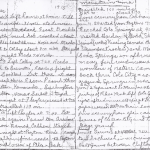
This gallery contains 10 photo.
This fascinating diary transcript from Olive Kobler documents the Kobler family trip from Penokee, KS to the San Francisco, California World Fair, also known as the Panama-Pacific International Exposition, in 1915 in a Lincoln Town Car, which actually came with a tent that was part of the car. Family members included Carl and Elma, Olive (16), Leo (12), Marie (9), Otto (7), Raymond (2). The trip duration was over 3 months, from June 8 through September 18. It was undoubtedly […]
Getting Started Guide
Please view the ancestry Help Me document to learn a few basics on how to interact on this website.
Kobler Photo from 1939
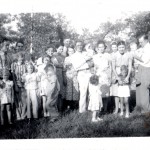
This gallery contains 1 photo.
I think this photo was taken about 1939. We need some help to identify the unknown people in the photo. I cannot identify some of the folks. On the left is Uncle Leo and Juanita in front of him, then Jo, (and what looks to be a Kobler man behind her who I do not know), me [Lois], Jocelyn, Dean in front of her, Jean behind her, Mom, Dad, a woman I do not know,back to the front a […]
John and Mary Kobler Family Photos
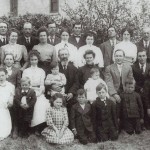
This gallery contains 7 photo.
Back Row: Herbert, Carl, Ernest, Eda Front Row: Arthur, John, Mae, Mary, Albert, William Not positive on the names. Just going by appearance and suspected chronological ages from JF Kobler’s obituary. According to LaVergne Hardman(oldest daughter of Albert who is 95 in 2012) This is the lineup of the picture … Back Row: Carl Kobler, Will Higer, Herbert Kobler, Art Kobler, Will Kobler, Doc Ebnother Second Row: Elma Kobler, Eda Higer,Carrie Kobler, Gertie Kobler, Nellie Kobler Third Row: Fred Kobler, […]
Carl Kobler Newspaper Articles
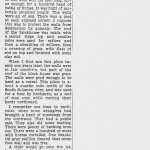
This gallery contains 1 photo.
Here are some very interesting newspaper articles written by Carl Kobler. The following is a very interesting account of life on the Kansas frontier, complete with descriptions of horse thievery and loosing your pants … literally! Kobler Family Article – by Carl Kobler – 1955 (PDF) And another article … The Old Sod Fort – by Carl Kobler – 1955 (PDF)
John and Mary Kobler Homestead

This gallery contains 8 photo.
Back Row: Mae Kobler, Elma Paxson Kobler (teacher), Lillian Gates, Fred Kobler, Albert Kobler, Art Kobler Front Row: Lola Gates, Olive Kobler, Freda Brinkmeyer, Ada Gates, Charlie Higer, Bob Gates, Charley Brinkmeyer
John and Mary Kobler Biography
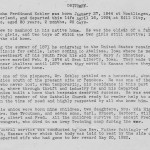
This gallery contains 4 photo.
John Ferdinand Kobler was born on 27 Jan 1844 in Montlingen, Switzerland. He died on 16 Apr 1924 in Hill City, KS. He married Mary Jacobea Ebnother, daughter of John Jacob Ebnother and Magadalena Nachbaur on 08 Feb 1874 in West Liberty, IA. She was born on 05 Sep 1856 in Montlingen, Switzerland. She died on 20 May 1920 in Hill City, KS. For more information about the Ebnother family, there is an interesting article about Mary’s brother, Dr. Charles […]
Ancestor Trees
Ancestor tree for J.F. & Mary Children
J.F. & Mary Kobler Children Ancestor Tree (PDF)
Here is an ancestor tree for the children of Carl & Elma Kobler … Olive, Leo, Marie, Otto, Raymond. The roots of Elma Paxson Kobler is well documented in the Paxson, Hadley and Holiday lines, dating back as far as the 1500s.
Carl & Elma Kobler Children Ancestor Tree (PDF)
Carl and Elma Kobler
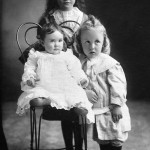
This gallery contains 3 photo.
Carl L. Kobler was born 2/15/1876 in Atalissa, Iowa. Carl married Elma Matilda Paxson on 5/1/1898. He died 7/19/1967 in Graham County Hospital in Hill City, KS. Buried in Penokee,KS Cemetery. Elma Paxson was born in Pleasant Plain, Iowa on 11/08/1877. Elma Paxson Kobler died 10/10/1960 in Hill City, KS and is buried in the Penokee Cemetery. Carl and Elma were both school teachers at one time. They owned many acres along the Solomon River in Graham County Kansas. They […]